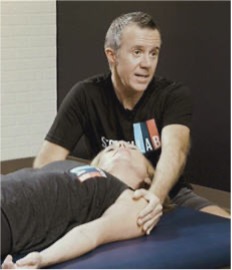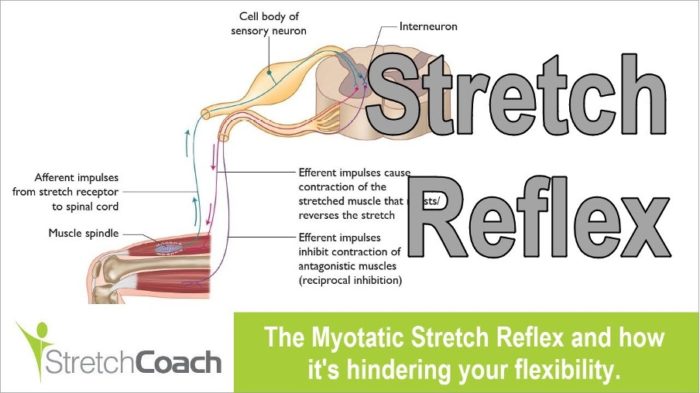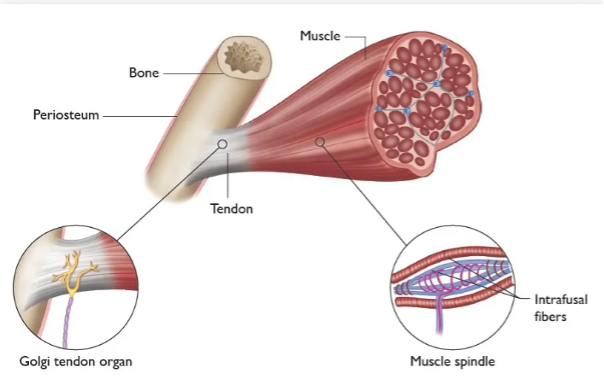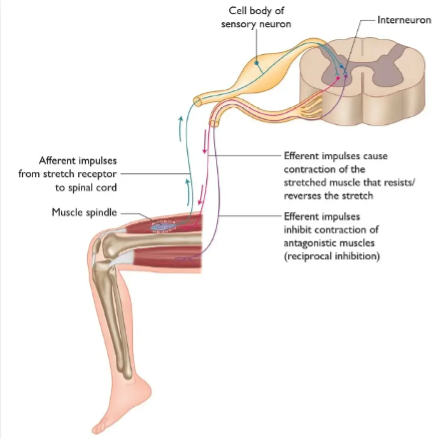Understanding the Stretch Reflex (or Myotatic Reflex)

About the Author: Brad Walker is often referred to as the “Stretch Coach” and has even been called the Stretching Guru. Magazines such as Runners World, Bicycling, Triathlete, Swimming & Fitness, and Triathlon Sports have all featured his work. Amazon (author page) has listed his books on five Best-Seller lists. Google cites over 100,000 references to him and his work on the internet. And satisfied customers from 122 countries have sent 1,000’s of verified customer reviews. If you want to know about stretching, flexibility or sports injury management, Brad Walker is the go-to-guy
What is the Stretch Reflex and how can you use it to improve your flexibility?
by Brad Walker |
The nervous system of mammals is very complex. For most major actions in the body the brain must decide what movement or action must be taken, the nerve impulses must be transmitted out of the brain, down the spinal cord and out to the intended receiver. Then when the action is carried out the impulse must return back via the reverse pathway to tell the brain it was completed and start the next process. This is the path for any brain-controlled, conscious, impulses. Although it takes a lot of words to explain, it is really a very rapid process.
However, there are many processes in the body that do NOT require direct thought to complete. The heart functions, breathing, metabolic processes, disease fighting and many other autonomic processes happen automatically in the body. The body uses signals to increase, decrease, or maintain many of these actions. If the carbon dioxide levels in the body begin to rise, for example, the autonomic nervous system calls for an increase in respiratory rate.
Another automatic response by the nervous system is the reflex. The body reacts in a predetermined way based on specific stimulus. This may be a practiced response or a pre-programmed one. The stretch reflex (or myotatic reflex) is one of those responses.
What is the Stretch Reflex?
The stretch reflex (also called the myotatic reflex, the muscle stretch reflex and sometimes the knee-jerk reflex), is a pre-programmed response by the body to a stretch stimulus in the muscle. When a muscle spindle is stretched, an impulse is immediately sent to the spinal cord and a response to contract the muscle is received. Since the impulse only has to go to the spinal cord and back, not all the way to the brain, it is a very quick impulse. It generally occurs within 1-2 milliseconds.

The stretch reflex is designed as a protective mechanism, to prevent strain and tear injuries to the muscles and tendons. When the muscle spindle is excited, an impulse is immediately received to contract the muscle, thereby protecting it from being pulled forcefully or stretched beyond a normal range of motion.
The synergistic muscles, those that produce the same movement, are also innervated when the stretch reflex is activated. This further strengthens the contraction and prevents injury. At the same time, the stretch reflex has an inhibitory aspect to the antagonist muscles. When the stretch reflex is activated, the impulse is sent from the stretched muscle spindle and the motor neuron is split so that the signal to contract can be sent to the stretched muscle, while a signal to relax can be sent to the antagonist muscles. Without this inhibitory action, as soon as the stretched muscle began to contract the antagonist muscle would be stretched causing a stretch reflex in that one. Both muscles would end up contracting simultaneously.
Side note: The deep tendon reflex (sometimes referred to as the Golgi tendon reflex) helps prevent injury by enabling a muscle to respond to increases in tension. If a muscle is put under excessive tension (contraction) the Golgi tendon organs (GTO’s) are excited and the deep tendon reflex is activated, which causes the muscles to relax, thereby protecting the muscle from being over stretched or torn. Note that in day-to-day movement, tension in the muscles is not sufficient to activate the GTO’s deep tendon reflex. By contrast, the threshold of the muscle spindle stretch reflex is set much lower.

Examples of the Stretch Reflex in action
The stretch reflex is very important in posture. It helps maintain proper posturing because a slight lean to either side causes a stretch in the spinal, hip and leg muscles to the other side, which is quickly countered by the stretch reflex. This is a constant process of adjusting and maintaining. The body is constantly under push and pull forces from the outside, one of which is the force of gravity.
Another example of the stretch reflex is the knee-jerk test performed by physicians. When the patellar tendon, located just below the kneecap, is tapped with a small hammer, or other device, it causes a slight stretch in the tendon, and consequently the quadriceps muscles. The result is a quick, although mild, contraction of the quadriceps muscles, resulting in a small kicking motion.
Anatomy of the Myotatic Reflex
Located within the belly of the muscle, between and parallel to the main muscle fibres, are muscle spindles. These muscle spindles are made up of spiral threads called intrafusal fibres, and nerve endings, both encased within a connective tissue sheath. These spindles monitor the speed at which a muscle is lengthened and are very sensitive to stretch.
If a muscle is stretched (lengthened) too far or too quickly the muscle spindles are excited and the stretch reflex is activated, which causes the muscles to contract, thereby protecting the muscle from being over stretched or torn.
These impulses travel from the spinal cord to the muscle and back again in a continuous loop. Conscious movement comes from impulses in the brain travelling down the spinal cord, over this loop, and then back to the brain for processing. The stretch reflex skips the brain portion of the trip and follows the simple loop from muscle to spinal cord and back, making it a very rapid sequence.

The diagram below shows how nerve impulses triggered by the stretch reflex travel between the spinal column and the muscles.
The gamma efferent cells in the loop work to keep the muscles ready for the stretch reflex, even when inhibited or contracted. This is important because if the muscle is working against a load and shortening during contraction and an additional load is added, the muscle recognizes the stretch immediately and can compensate with a stronger contraction. This also protects the inhibited antagonist muscles from being injured from excessive stretching.

Stretch reflex anatomy pictures used from
The Anatomy of Stretching. Copyright © Bradley E. Walker For a copy go here
Important: The length of time that a stretch is held for has nothing to do with whether the stretch reflex is activated or not. Don’t let anyone tell you that the stretch reflex is not activated because the stretch is only held for one or two seconds. The stretch reflex in the calf muscle for example is triggered within 3 hundredths of a second, so any claim that a particular type of stretching can somehow bypass or outsmart the stretch reflex is nothing more than fantasy.
What Activates the Stretch Reflex?
The stretch reflex is activated (or caused) by a stretch in the muscle spindle. When the stretch impulse is received a rapid sequence of events follows. The motor neuron is activated and the stretched muscles, and its supporting muscles, are contracted while its antagonist muscles are inhibited (relaxed).
The stretch reflex can be activated by external forces (such as a load placed on the muscle) or internal forces (the motor neurons being stimulated from within.) An example of the former is a person holding an empty tray in their outstretched arm and then having a plate of food set on it. The stretch reflex would kick in to keep the tray at the same height and balanced. An example of the latter would be the shivering of a cold muscle. The motor neurons are stimulated from an internal “stretch” to warm the muscles.
Any abrupt, forceful stretch on the muscle causes the stretch reflex to fire, in a healthy person. Delays in or absence of the stretch reflex are signs of possible neurological or neuromuscular compromise.
Avoiding the Stretch Reflex
Many people have never learnt how to stretch properly. Maybe you have done this yourself: You watch other people stretch in the gym and try to imitate what you see. But who is to say that the person you are watching is doing it right? Here are some of the most common mistakes made while stretching:
- Bouncing. Many people have the mistaken impression that they should bounce to get a good stretch. Bouncing will not help you and could do more damage as you try to push too far beyond the stretch reflex. Every move you make should be smooth and gentle. Lean into the stretch gradually, push to the point of mild tension and hold. Each time going a little further, but never forcing it.
- Not holding the stretch long enough. If you do not hold the stretch long enough, you may fall into the habit of bouncing or rushing through your stretch workout. Hold your stretch position for at least 15 to 20 seconds (and up to 60 seconds for even better results) before moving back to your original position.
- Pushing the stretch too hard. Stretching takes patience and finesse. Each move needs to be fluid and gentle. Do not throw your body into a stretch or try to rush through your routine. Take your time and relax.
- Forgetting form and function. Think about your sport or activity. Which muscles will you be using? A routine for a marathon runner will be very different from a routine for an hour of lifting weights. Pay attention to the muscles you will need to use in your program and make sure your form for each stretch is attained properly. Consider the range of motion you will be putting that particular muscle through. The whole point of stretching is getting your muscles accustomed to moving through a specific range of motion, so if the muscle is not used to going that far, you may end up with an injury.
So, to avoid the stretch reflex and potential damage to your muscles and joints, avoid pain. Never push yourself beyond what is comfortable. Only stretch to the point where you can feel tension in your muscles. This way, you will avoid injury and get the maximum benefits from your stretching.
Email: contact@stretchcoach.com
Website: https://stretchcoach.com/
To grab a copy of Brad’s Ultimate guide to stretching and flexibility, go here